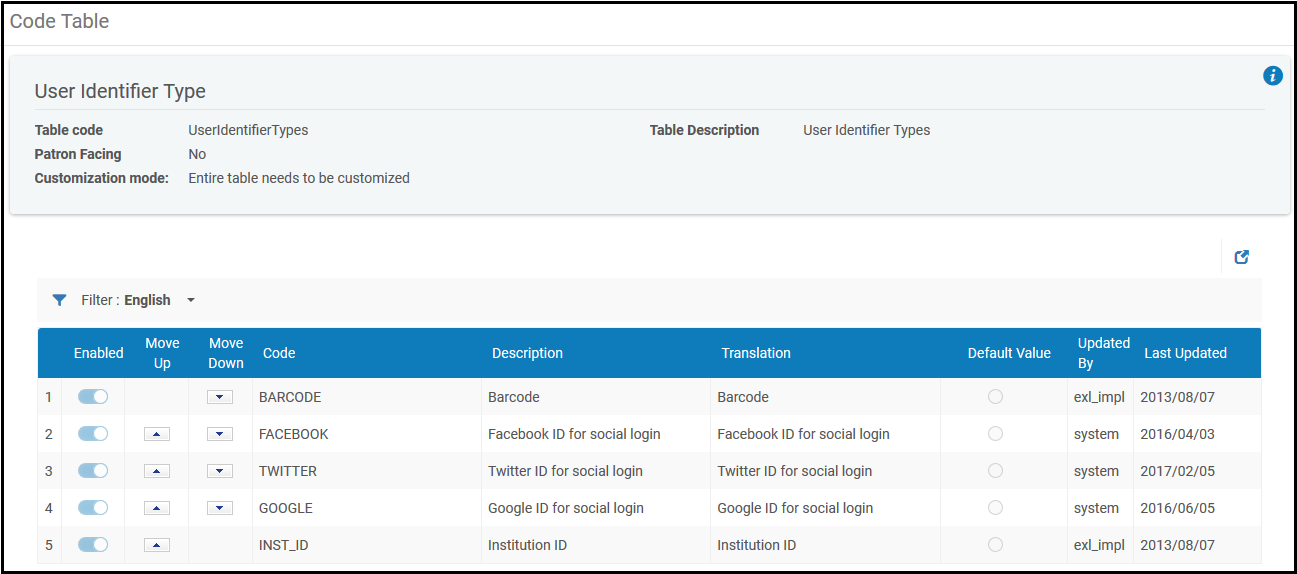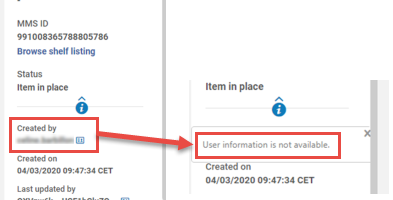Managing User Identifiers
User Identifiers Overview
User identifiers are an integral part of Alma's user accounts. They identify the user's account and can be used to connect the user's account with external accounts, such as a Student Information System, other institutions in a fulfillment network, or a social media account.
Every Alma and Primo user has a primary identifier. Your institution can optionally enable additional user identifiers that are available (or required) to be added to a user based on the user's record type: Public or Staff. Contact users cannot be assigned any additional user identifiers.
When you require them to do so, Circulation Desk Managers/Operators add a user identifier when they register patrons on the Patron Identification page (these are users with a) record type Public and b) role Patron). While Circulation Desk Managers/Operators can edit some user information from the Patron Services page, they cannot view or edit user identifiers from this page (they can view the primary identifier only).
User Managers/Administrators add or edit additional user identifiers when they add or edit users on the Find and Manage Users page (see Managing User Identifiers (Tab)).
Configuring User Identifier Types
Before adding additional user identifiers, the identifier types must be configured. Ex Libris creates and configures the types when setting up your institution.
Afterwards, a User Administrator or General System Administrator completes the configuration by configuring whether at least one additional user identifier type is mandatory, and the default identifiers that are generated automatically when registering patrons.
- Ex Libris configures the list of additional user identifier types for each institution. You can see the list of identifiers for your institution in the User Identifier Types page (Admin > User Management > User Identifier Types). However, most institutions have at least the following user identifier types available:
- Twitter ID, Facebook ID, and Google ID - For use when enabling social logins
- IDs relevant for Esploro (you can ignore these if your institution is not using Esploro; for more information about Esploro, see Esploro Overview.)
- Barcode
- Any other user identifier types required
When configuring the list of additional user identifier types, Ex Libris can set which types are available to be added to staff users and/or public users (including patrons). - To configure whether at least one additional user identifier type is mandatory when adding a user, add the Identifier 1 field for the relevant record type; see Configuring Patron Registration Forms. When registering a patron, you can add a user identifier type (other than the primary identifier) only if Identifier 1 is configured as a mandatory field.
- To configure the automatic generation of user identifiers when registering patrons, see Configuring User ID Generation. You can configure different automatically generated values for the primary identifier or for any other user identifier. Automatically generated identifiers appear only when a circulation desk operator registers a new patron from the Patron Identification page; identifiers are not automatically generated when adding users from the Find and Manage Users page.
- To require that the primary identifier be in a specific format, configure primary_identifier_regex; see Configuring Other Settings.
- To configure the user identifier that is displayed when scanning items that are on the hold shelf, configure preferred_identifier; see Configuring Other Settings.
Viewing Additional User Identifier Types
To view additional user identifier types, you must have one of the following roles:
- User Manager
- User Administrator
The User Identifier Type code table (Admin > User Management > User Identifier Types) contains the list of additional user identifier types. For more information about code tables, see Code Tables. This page is not visible to users and can be configured only by Ex Libris.

User Identifier Type Code Table
The list typically includes a barcode, a code to indicate the ID from the student information system, and any social media IDs supported for your institution.
Adding and Editing User Identifiers
To add user identifiers to patrons, you need one of the following roles:
- Circulation Desk Manager
- Circulation Desk Operator
- Circulation Desk Operator-Limited
- User Manager
- User Administrator
- Adding user identifiers to a patron: You add a primary identifier to a patron when registering the patron; see Registering Patrons. You must add an additional user identifier in this scenario when a mandatory user identifier field is configured. The primary or any other user identifier may be pre-filled with a generated value; see Configuring User ID Generation. When configured by your library, you may have to enter the primary identifier in a specific format.
When editing the patron's user information, you can view, but not edit, only the primary identifier.
- Adding or editing user identifiers for any user: You add a primary identifier to a user when adding a user (see Adding Users) or when editing users (Managing User Identifiers (Tab)). When adding a user, a primary identifier is mandatory. In addition, another user identifier is mandatory when a mandatory user identifier field is configured; see Managing Patron Services. When configured by your library, you may have to enter the primary identifier in a specific format.
When editing a user, you can add, edit, or remove additional user identifiers (you can view, but not edit, the primary identifier). The list of available identifier types might be different for different user types (staff or public).
- An external user displays the primary identifier in two places on the User Details page - the header and the user information section. In some cases, these identifiers may be different. The primary identifier in the header is the preferred identifier.
- If the primary identifier of a user is changed, it will currently cause users to lose access to their private sets and private rules in the Metadata Editor. In addition, when editing a primary identifier of a user, the associated records in the information (
 ) icon are lost.
) icon are lost.
 Information icon without associated records after editing a primary identifier for a user
Information icon without associated records after editing a primary identifier for a user
Mapping User Accounts to Other Systems
You can map your user accounts to user accounts in external systems either by mapping your user identifier in Alma to the identifier in the other system or by sharing your identifiers with other systems.
- Student Information System (SIS) - When your institution already manages users in a SIS, Alma needs only to a) retrieve the user information from the SIS and b) store only Alma-specific information for the user. For example, the user names, passwords, and user identifiers may be managed in the SIS, while the user's loans and purchase requests are stored in Alma. User identifiers for external users can be marked as internal (managed in Alma) or external.
SIS information is imported on a regular basis to Alma using an integration profile. Information from the SIS overwrites any relevant conflicting information in Alma. For more information, see SIS Overview in the Developer Network and Student Information Systems. You can define multiple SIS integration profiles, one for each combination of SIS and user record type. When defining a profile, you select the user identifier in Alma to use to match the record exported from the SIS.
If your SIS does not offer not offer authentication services, can create users as external in Alma, but assign passwords for them directly in Alma. In this case, all the user information is managed from the SIS, but the passwords are stored in Alma and managed by the Ex Libris Identity Service. When the user logs in, Alma attempts both the external IdP and the internal one. If you would like to activate this behavior, please contact Ex Libris customer support.You can also use the integration profile to export user information to the SIS, such as user blocks and outstanding fines/fees. Fines/fees can also be exported to a bursar system and payments imported from the bursar system into Alma (see Bursar in the developer's network and Bursar Systems). Similarly to the SIS integration profile, you must select the relevant user identifier when configuring the bursar integration profile. - External Authentication: SAML, CAS, LDAP, Cloud IDP - If you use an external authentication system, you may need to map Alma user IDs to the IDs used by the external system. For more information, see Institutional Identify Provider in the Developer Network and Authentication.
- Social Login - You can enable users to log in to Alma using a social login profile (Google, Twitter, or Facebook). In these cases, the user's social login user name must be stored as an additional user identifier before the user logs in. See Social Login in the Developer Network and Social and Email Login.
Login using a link sent by email is also available. This feature uses the user's email address, which is not (technically) considered a user identifier in Alma.
- Primo - Primo users are authenticated using a user identifier when retrieving information from Alma' see Primo in the Developer Network.
- Fulfillment Network - By default, primary identifiers at different institutions in a fulfillment network are unrelated, and therefore do not have to be unique between institutions. You can configure that primary identifiers must be unique throughout the entire fulfillment network; see Sharing User IDs within a Fulfillment Network in a Network Zone.
When registering a patron at a circulation desk, or adding a user to Alma on the Find and Manage User page, you can connect the new patron/user by selecting Find user in other institution. See Registering Patrons for details.
- Network Zone - You can centrally manage users in a Network Zone; see Centrally Managing Users in a Network Zone.

